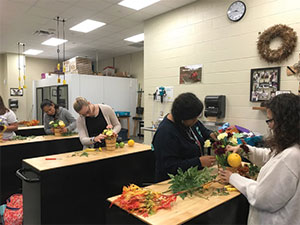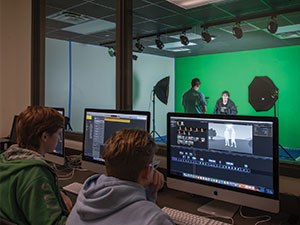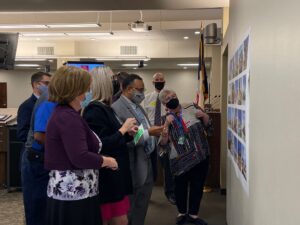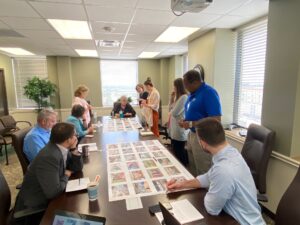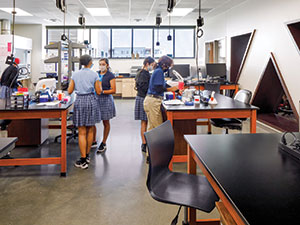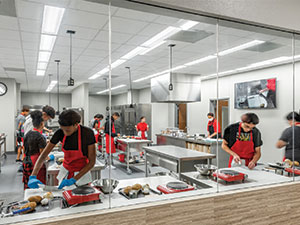CTE Learning Environments: Flexing for the Future
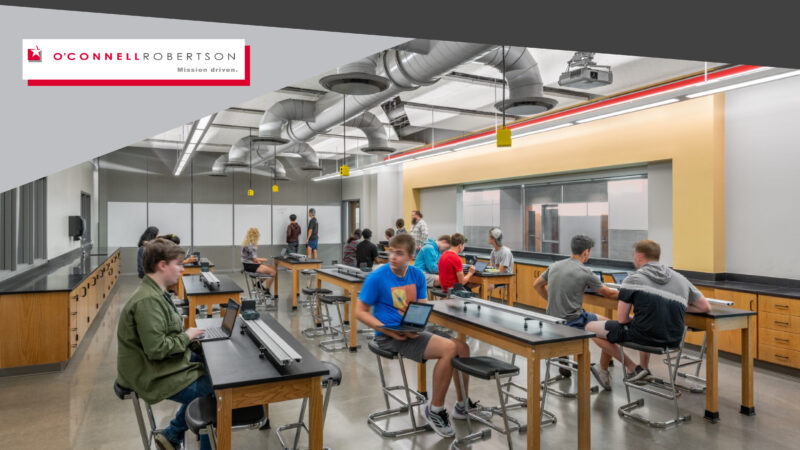
CTE Learning Environments: Flexing for the Future
Written By: Jayna Duke, IIDA, LEED AP, Principal, Interiors Practice Leader
Over the past few decades, Career & Technology Education (CTE) has evolved in unexpected ways. From floral design to robotics, to coding and technology, and media of all types – CTE isn’t a new concept, but the ways our schools teach it and the spaces required are very different.
CTE Program Evolution
The pace of technology evolution isn’t slowing down anytime soon. This means intentional and flexible designs are significant priorities for CTE. Planning for variety in space usage and forecasting what potential learning will look like requires collaboration among architects, engineers and interior designers to create spaces for career tech education today that will still be useful in the future.
“There is a comprehensive nature to design that is a blend of Engineering, Architecture and Interior Design, of systems and aesthetics, of the intentional and the unexpected. Our first responsibility as a Design Team is to serve the needs of our clients, both today and in the many years of a building’s life cycle. As technology evolves, learning styles develop, and the environment of collaboration needs to be able to shift or even predict the needs of future learners. Crafting spaces for flexible experiences through collaboration with Stakeholders and Designers is key to providing an impactful canvas for learning.” says Chris Narendorf, Principal, Director of the San Antonio Office for O’Connell Robertson.
Collaboration in Action
One example of this collaboration in action was the new Waco High School project.
During our programming workshops with user groups at Waco ISD, almost every department brought up how important the media tech group was in documenting and promoting their programs. Designers from O’Connell Robertson recognized that one reason for the media tech program’s broad impact was due to their proximity to the other programs. Originally, this proximity was established because the media tech group had been spread out into four separate locations, but lacked the internal collaboration of proximity within the group. An important programming request was to enhance the internal collaboration among media tech team members through the new space. The desire was to achieve this by consolidating the media tech program into a single location.
Balancing the needs of the media tech group with the ability to collaborate with other programs and departments required deliberate design. How could the media tech group be centrally located, so that they can be together internally within their department AND still be connected to the rest of the school? The other departments wanted convenient access to stop by and integrate media into their projects. In order to maintain the broad reach and interactive impact of this specific program, but also provide the strength and consolidation requested, designers determined locating the media tech program on a highly visible, central corridor would serve both purposes.
The Importance of Integration
Relational and spatial planning for education environments takes into consideration both physical and visual connections to create cues, reminders and signals that showcase how each department and space work together within an integrated facility.
One of the ways O’Connell Robertson’s design team adds value to education projects is by understanding how different spaces get used throughout the day. For instance, many schools have common areas that serve multiple functions for a variety of groups at different times. When designers understand these interactions and interface points, a space can be designed that fosters and supports each individual use.
Flexibility and Budget
In CTE schools, it is also vital to consider how specialty education programs will interface with core academics. Flexibility is key to ensure that if programming changes, if different areas of focus become necessary, the school can adjust accordingly without incurring substantial cost. Designers imagine what happens in a space and then make intentional selections that will support the occupants.
We have seen that interior design can have a positive or negative impact on function, flow, behavior, and emotional responses to place. Thoughtful design decisions can positively impact these factors without changing cost.
Designing for People
Our Firm is full of passionate designers who truly want to positively impact our community. We understand that people experience spaces in different ways, so we work collaboratively as a team every day to design environments that fuel innovation for learning.
Above all else, designing with people at the forefront means understanding the use spaces and establishing the elements that will allow people to live that story in the spaces created.
If you have any questions about designing for CTE programs, please contact me at [email protected].


